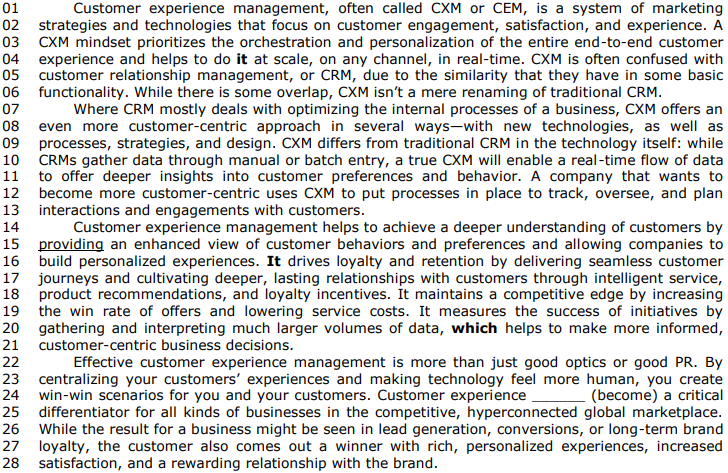Questões de Concurso
Sobre inglês
Foram encontradas 18.859 questões
Resolva questões gratuitamente!
Junte-se a mais de 4 milhões de concurseiros!



What is customer experience management?

(Available at: www.dynamics.microsoft.com/en-us/marketing/what-is-customer-experience-management-cxm/
– text specially adapted for this test).
What is customer experience management?

(Available at: www.dynamics.microsoft.com/en-us/marketing/what-is-customer-experience-management-cxm/
– text specially adapted for this test).
What is customer experience management?

(Available at: www.dynamics.microsoft.com/en-us/marketing/what-is-customer-experience-management-cxm/
– text specially adapted for this test).
What is customer experience management?

(Available at: www.dynamics.microsoft.com/en-us/marketing/what-is-customer-experience-management-cxm/
– text specially adapted for this test).
What is customer experience management?

(Available at: www.dynamics.microsoft.com/en-us/marketing/what-is-customer-experience-management-cxm/
– text specially adapted for this test).
( ) CXM and CRM are practically the same thing, except for the methods of analyzing customer behavior.
( ) CXM is capable of analyzing a high volume of data and then provide important information to help decision-making.
( ) Customers also benefit from companies using CXM because they have more satisfying experiences.
The correct order of filling the parentheses, from top to bottom, is:
Keeping in mind the ideas expressed above and the linguistic aspects of the text, judge the following item.
It is correct to conclude from the text that the total number of
students who signed up for the three free online courses
offered by Stanford in 2011 was higher than 300.000.
Keeping in mind the ideas expressed above and the linguistic aspects of the text, judge the following item.
The phrase “short for massive open online courses” (in the
last sentence of the first paragraph) can be correctly replaced
with which stands for massive open online courses.
Keeping in mind the ideas expressed above and the linguistic aspects of the text, judge the following item.
According to third paragraph of the text, more than
220 million students registered on MOOC platforms during
the so called “Year of the MOOC” — 2021.
Keeping in mind the ideas expressed above and the linguistic aspects of the text, judge the following item.
The text can be described as an introduction to a definitive
list of countries that offer MOOCs.
Keeping in mind the ideas expressed above and the linguistic aspects of the text, judge the following item.
The verb “prompted” (in the second sentence of the third
paragraph) conveys the same idea as restrained.
Text CB1A7
Whenever a global economic transformation takes place, a single city usually drives it forward. Ghent, in modern-day Belgium, was at the core of the burgeoning global wool trade in the 13th century. The first initial public offering took place in Amsterdam in 1602. London was the financial centre of the first wave of globalisation during the 19th century. Today the city is San Francisco.
California’s commercial capital has no serious rival in generative artificial intelligence (AI), a breakthrough technology that has caused a bull market in American stocks and which, many economists hope, will power a global productivity surge. Almost all big AI start-up companies are based in the Bay Area, which comprises the city of San Francisco and Silicon Valley (largely based in Santa Clara county, to the south). OpenAI is there, of course; so are Anthropic, Databricks and Scale AI. Tech giants, including Meta and Microsoft, are also spending big on AI in San Francisco. According to Brookings Metro, a think tank, last year San Francisco accounted for close to a tenth of generative AI job postings in America, more than any other city of the country. New York, with four times as many residents, was second.
Internet: <www.economist.com> (adapted).